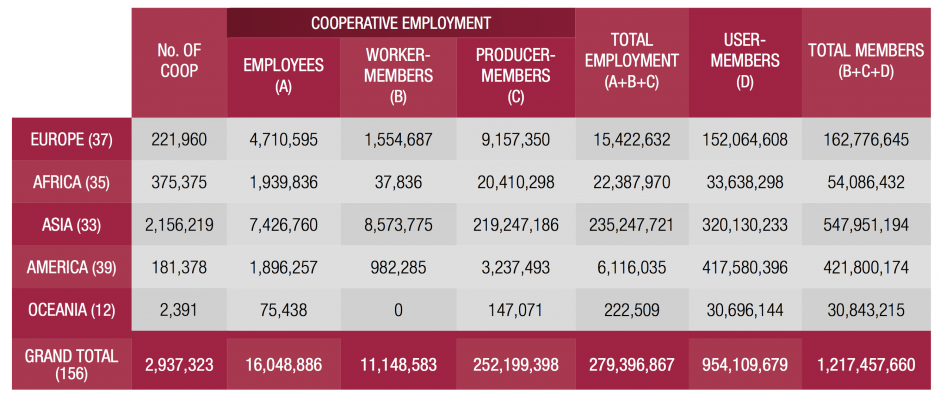There are almost three million co-ops that employ 10% of the global employed population.
A report from CICOPA [pdf], the international organisation of industrial and service co-operatives, looked at 156 countries, where it found there were 2,937,323 co-ops, and of that a total of 279,396,867 people employed – or 9.46% of the world’s employed population.
In addition, it also discovered there are over 1.2 billion members, of those 954 million are user members, while the rest are either worker-members or producer-members.

The researchers broke down the different types of co-operative employment into the following categories:
- Employees – people employed as workers by the co-operative
- Worker-members – includes different forms of worker ownership found in worker co-operatives, social co-operatives, multi-stakeholder co-operatives or community co-operatives
- Self-employed producer-members – Many co-operatives operate as an interface with people working as self-employed individual producers, such as farmers and artisans, who rely partly or totally on co-operatives in order to transform or commercialise their products or services, or to provide them with key production inputs.
Out of the main figure of people employed, 27.2 million work in co-operatives, including around 16 million co-operative employees and 11.1 million worker-members. Employment within the scope of co-operatives, comprising mainly self-employed producer-members, concerns over 252.2 million people, the vast majority being in agriculture.
Based on the data from the 2014 report, the number of people employed by co-ops has increased from 250 million to 279.4 million. However, this reflects the addition of information from more countries in the second report – 156, compared to 74 countries in the first report – rather than growth, the report says.
Geographically, the largest part comes from Asian countries. Due mainly to the considerable numbers from China and India, Asia represents a very large part of co-operative employment, regardless of the work forms. Whilst producer-members are the dominant form of co-operative employment (over 90%) in Asia and Africa, in Europe employees also account for a large proportion (30%). In America, worker- members represent an important portion of co-operative employment (16%), while the huge amount of user-members (more than 368,000 million out of 421.8 million in all American countries) are to be found primarily in the US and Canada.
Bruno Roelants, the secretary general of CICOPA, said: “Employment is one of the most important contributions made by co-operatives throughout the world. This report shows that people involved in co-operatives constitute a sufficiently high percentage to be considered as a major actor in the United Nations ‘2030 Agenda for Sustainable Development’, as well as in the worldwide debate on the ‘Future of Work’ launched by the International Labour Organization.
“In addition, the intent of the study is to improve the methodology and the quality level of co-operative statistics. This is particularly timely, as the next International Congress of Labour Statisticians will take place in 2018. The public authorities and the co-operative movement itself should pay particular attention to this forthcoming event.”